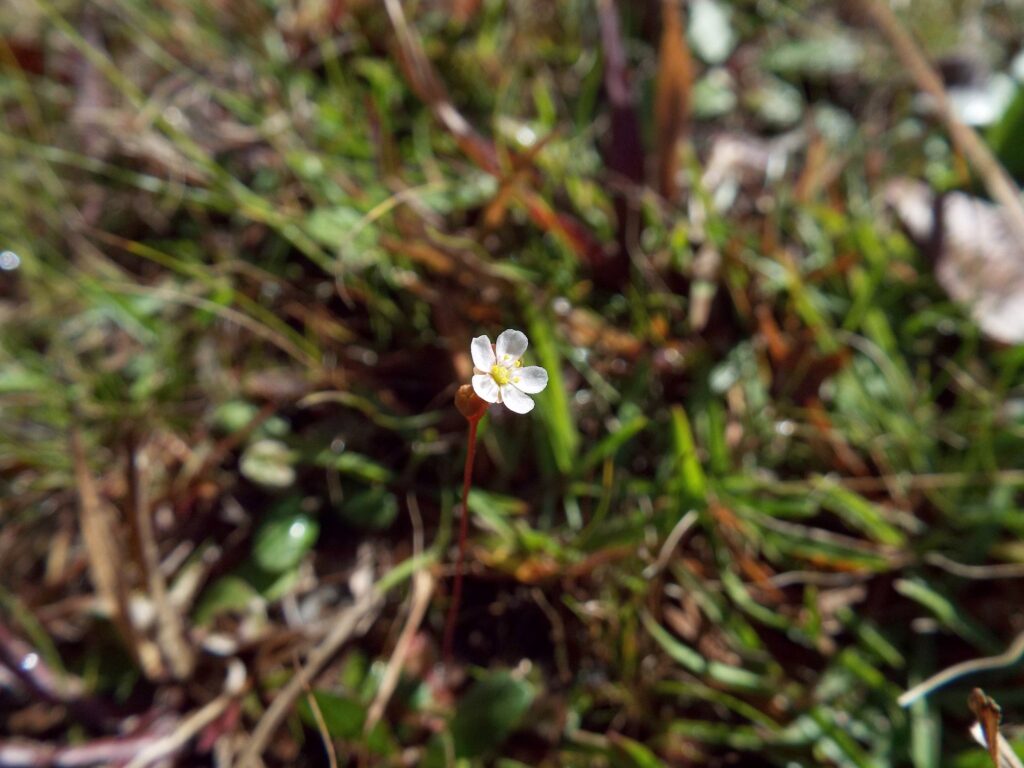
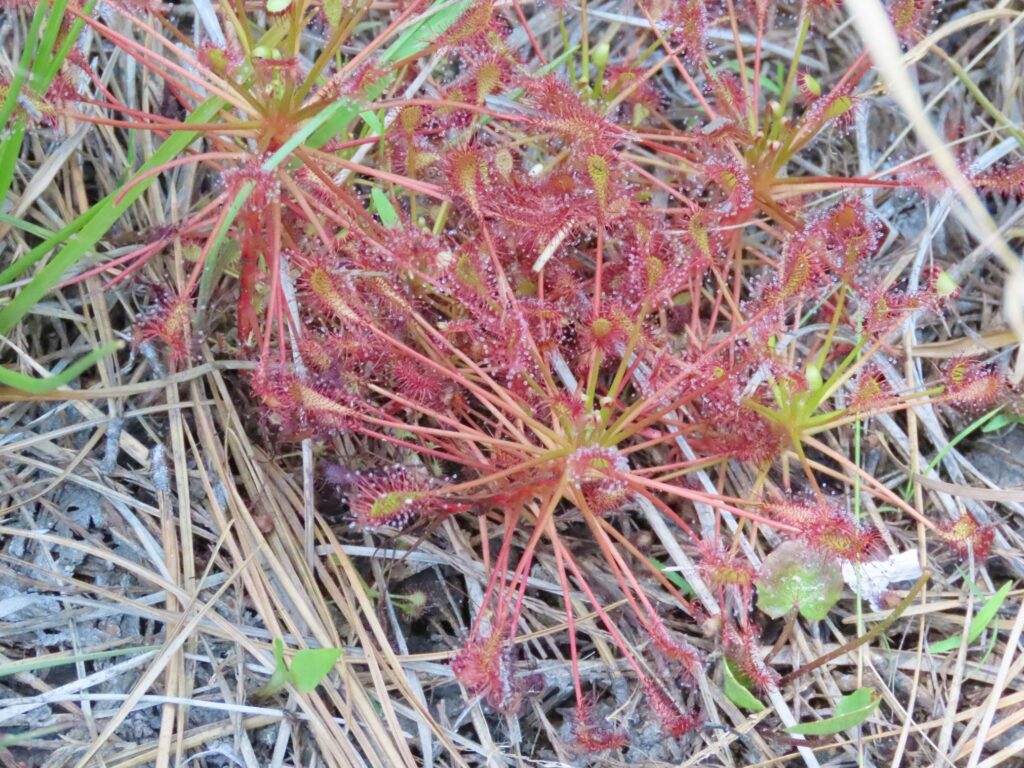
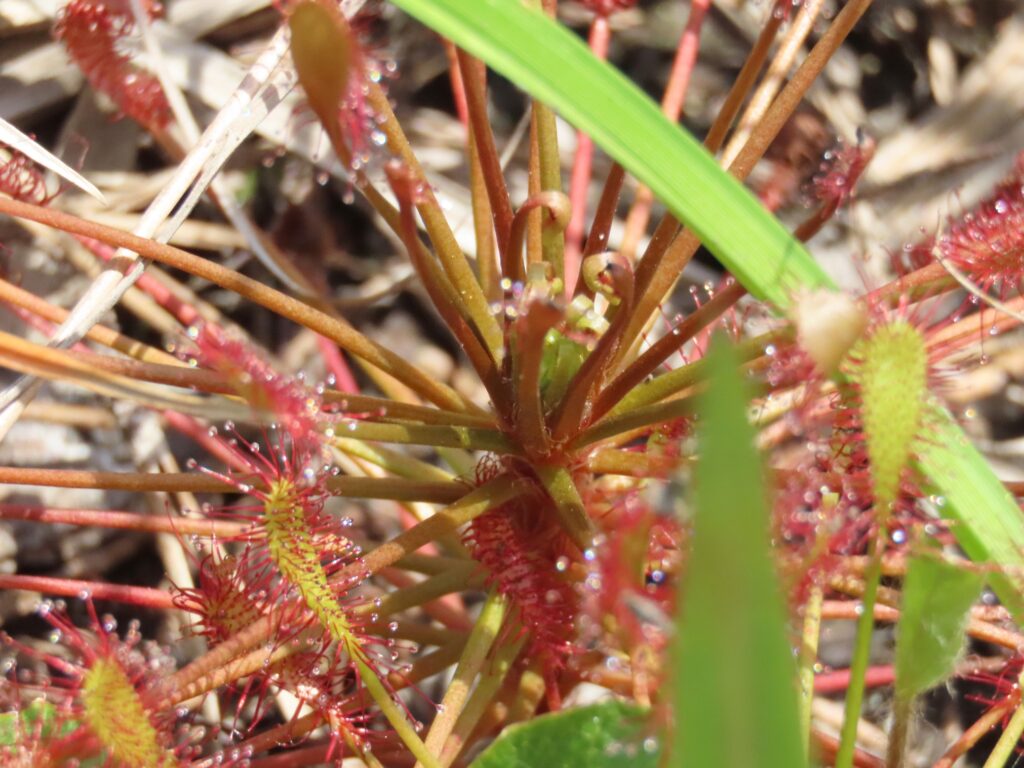
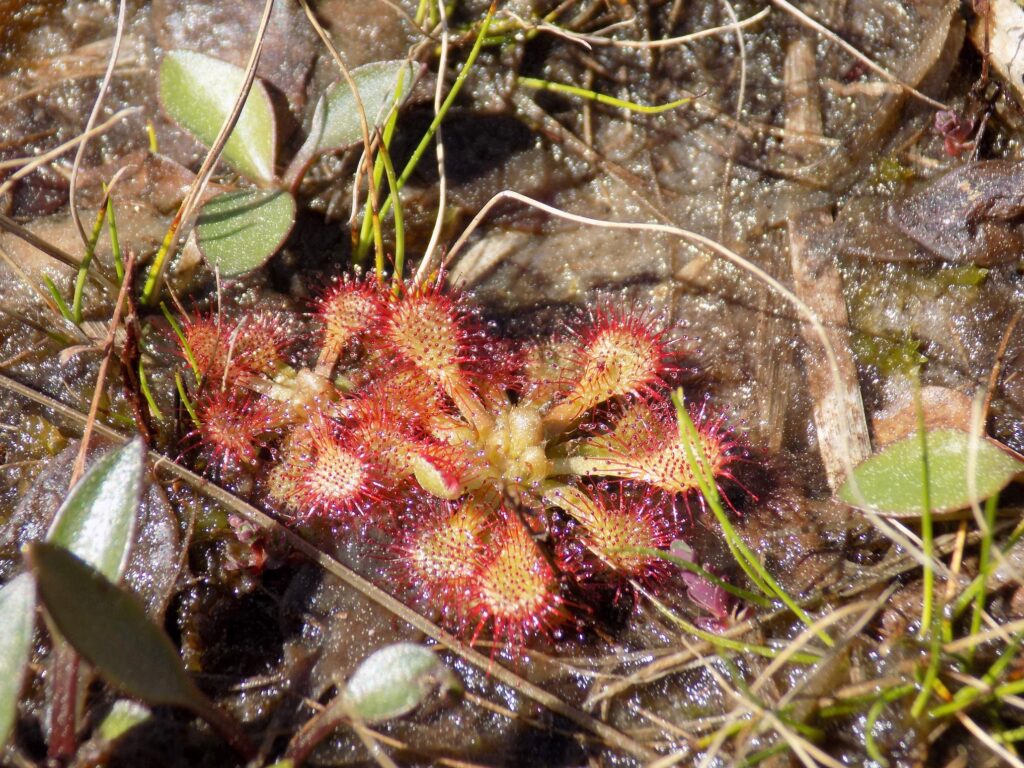
This week for Flora and Fauna Friday, it’s a small, sticky, bug-eating set of plants: the Sundews of genus Drosera.
Sundews are one of our more common groups of carnivorous plants but are still not all that easy to find. We have three widespread species of Sundew in South Carolina: Pink Sundew (Drosera capillaris), Spoon-leaved Sundew (D. intermedia), and Dwarf Sundew (D. brevifolia). All sundews prefer bare, sandy soils with plenty of moisture and are almost always encountered in Longleaf Pine savannas, flatwoods, the margins of carolina bays, and other fire-adapted habitats with adequate soils. They grow low to the ground as a rosette and are less than three-inches in diameter. Their bloom time peaks in early to mid-spring and their small, pale, five-petalled flowers appear atop long narrow stalks. Sundews can be either perennial or annual, depending on environmental conditions throughout the year. This genus is an easy one to identify here in the Lowcountry as all of our species share unique physical characteristics. Sundews have chartreuse and rosy-scarlet foliage with leaves that are spoon-shaped and covered in thick scarlet hairs. The means by which Sundews capture and eat insects is found on those scarlet hairs. The tip of each hair produces a tiny droplet of crystal clear liquid, like dew drops in the morning sun. This fluid is sweet smelling and attracts flies, ants, and other minute insects. When an insect lands on the leaf, the droplets adhere to it like glue, sticking it to the plant. Contact with prey also signals the leaf to cup or roll around the critter, increasing the number of hairs that make contact. The plant will then secrete digestive fluids through the ends of the hair and absorb the nutritious bug bits through the surface of the leaf.
Pink Sundew is probably the most common species in our area and needs wet sandy soil to survive. It is fairly small, usually only an inch or inch-and-a-half in width and with short leaves shaped like a wooden spoon. Its bloom time peaks throughout April and its flower is small and pale pink. Pink Sundew is perennial.
Spoon-leaved Sundew is most commonly found in acidic ephemeral wetlands and likely the hardest of today’s three to find. However, it’s certainly the easiest to identify. Spoon-leaved Sundew is much larger in size, at around two to three-inches in diameter, with long, narrow, oar-shaped leaves. The plant is a perennial, has a more three-dimensional globe-shape, and also grows taller over time but does not stay upright. Its flower is white and small relative to the size of the whole plant and its bloom time peaks in May and again in August.
Dwarf Sundew is the smallest of our Sundews but also the least habitat specific. It is similar in appearance to the Pink Sundew and prefers similar habitats but will tolerate drier soils. Dwarf Sundew grows to only about half-an-inch in diameter, stays flat to the ground, and has more teardrop-shaped leaves with hairs down to the bud. Its bloom time peaks between the end of March and early April and it does not have a secondary bloom period. The flower of Dwarf Sundew is white and, relative to the size of the plant, is quite large compared to our other two species.
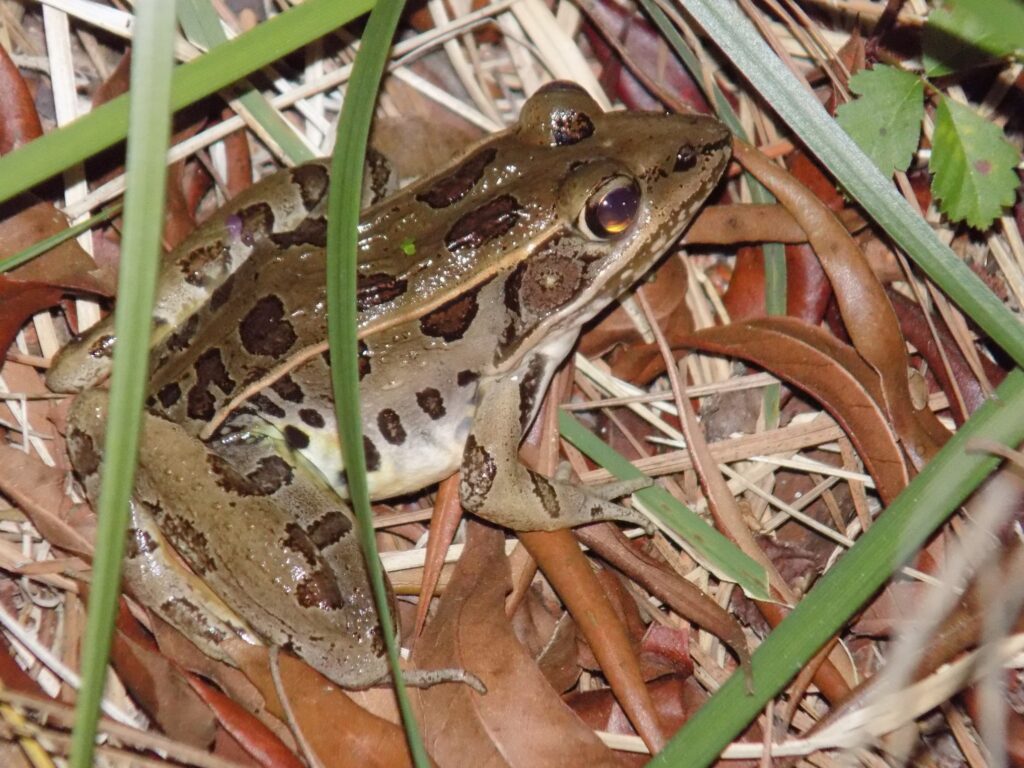
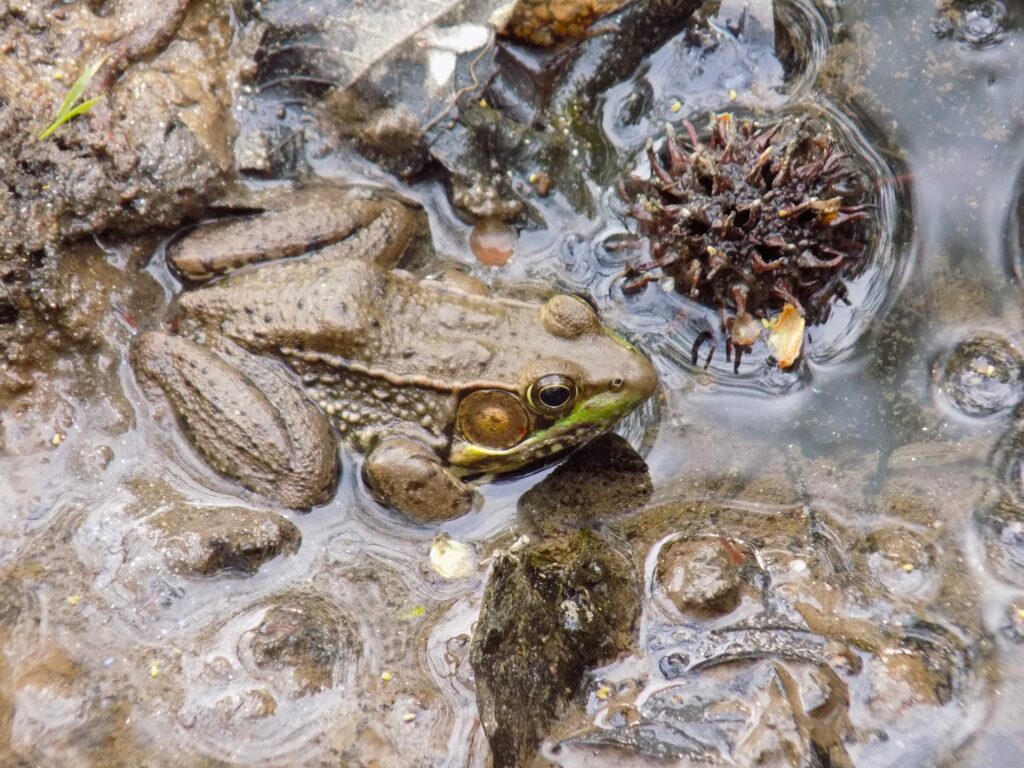

This week for Flora and Fauna Friday were listening in for the long-legged locals of genus Lithobates, the True Frogs.
The members of the genus Lithobates contains many of our most numerous and recognizable frogs. They’re designated as true frogs, with “true” here meaning something closer to “typical” or “normal”. Here in South Carolina we have nine species in the genus with eight in the Lowcountry. However, I’m just focusing today on the four species you’re likely to find on Edisto Island: Southern Leopard Frog (L. sphenocephala), Bronze Frog (L. clamitans clamitans), American Bullfrog (L. catesbeiana), and Pig Frog (L. grylio).
The Southern Leopard Frog is by far the easiest to identify, and probably also the easiest to find. They’re roughly three inches in length and have a distinctive pointed head, with their specific epithet “spenocephala” meaning “wedge-head”. They’re primarily bronze in color and sometimes a pine-green along the spine with two raised, ivory-white lines down each side of their back and small dark-brown blotches across the body. These blotches giving it the “leopard” part of the common name. The call of our Leopard Frog is unmistakable, sounding like someone flicking the teeth on a plastic comb except low pitched and variable in tone. Leopard Frogs can be found in pretty much any semi-permanent body of freshwater in the Lowcountry and are notably more tolerant of salt intrusion than most frogs.
The Bronze Frog is even more common than the Leopard Frog in certain areas and is the subspecies of the Green Frog found here in the Lowcountry. Bronze Frogs are usually about three to four inches in length and much smaller and browner than the Green Frog of the upstate. They have a bit of a point to their snout and raised ridges along the sides of their back. They’re an almost uniform dull-mocha or bronze color with a pale line above their lip. Their call is an easily recognized single note that can only be described as someone plucking a banjo string. Bronze Frogs can be found in much the same habitats as Leopard Frogs but seem to be a little more partial to woodlands and don’t have the same tolerance for salt.
The American Bullfrog is our third most common True Frog and definitely the largest, occasionally reaching eight inches in length but usually closer to five or six. Bullfrogs have a blunt snout, smooth back, and are generally a three color palette, with a sometimes mottled back and legs in brass, bronze, or green, a green face, and yellow throat. The song of the Bullfrog is a simple but loud and resonant “moo”, hence the “bull” part of the common name, or sometimes their call is a punctuated “jug-o-rum”, repeated once about every second. They’re commonly found in pretty much every permanent freshwater wetland, especially ponds.
The Pig Frog is our least abundant of the True Frogs but not a rare species. They’re about the same size as a Bullfrog at around four to five inches in length but tend to be smaller. The Pig Frog is similar in appearance to the Bullfrog too, with a smooth back (no ridges) and greenish coloration. However, the Pig Frog has a pointier snout and is usually a more uniform brass-green color across the body with small black spots. The serenade of the Pig Frog is, you guessed it, like to oink-ing of a pig. Usually just one or two “oinks” at a time but sometimes many. They’re found in permanent wetlands, usually large ponds, open swamps, and freshwater marshes. Pig Frogs are often easy to hear but hard to see, given their preference for swampy waterbodies.


This week for Flora and Fauna Friday it’s a magenta flower of the morning marsh, Saltmarsh Morning-Glory (Ipomoea sagittata).
Saltmarsh Morning-Glory is an herbaceous twining vine belonging to, unsurprisingly, the Morning-Glory family, Convolvulaceae, and shares much of the same characteristics with our other Morning-Glories. Salt Marsh Morning-Glory is a perennial vine that dies back to its roots each winter. It climbs by twining around surrounding grasses, forbs, and shrubs and generally stays fairly low to the ground, sometimes growing like a sparse groundcover. Its leaves are narrow and sharply pointed like an arrowhead, which is the origin for its specific epithet “sagittata” meaning “arrow-shaped”. The flowers of Saltmarsh Morning-Glory are that characteristic funnel-shape of Morning-Glories and, from the front, present a roughly three inch circle of magenta, deepening in richness towards the center. Morning-Glories get their name from their flowers, which open in the morning and wilt in the heat of the afternoon. This species of Morning-Glory is also easily recognized by its preference for sandy, moist soils along brackish impoundments and the fringes of tidal creeks. Sometimes even growing out into salt scrub meadows.
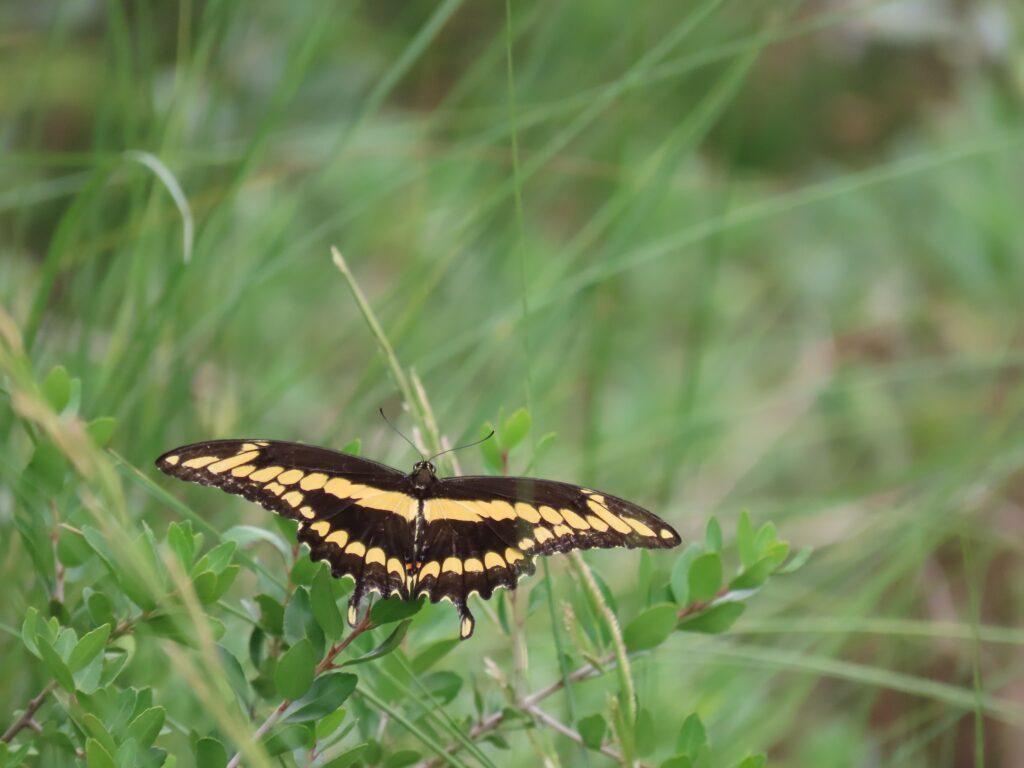

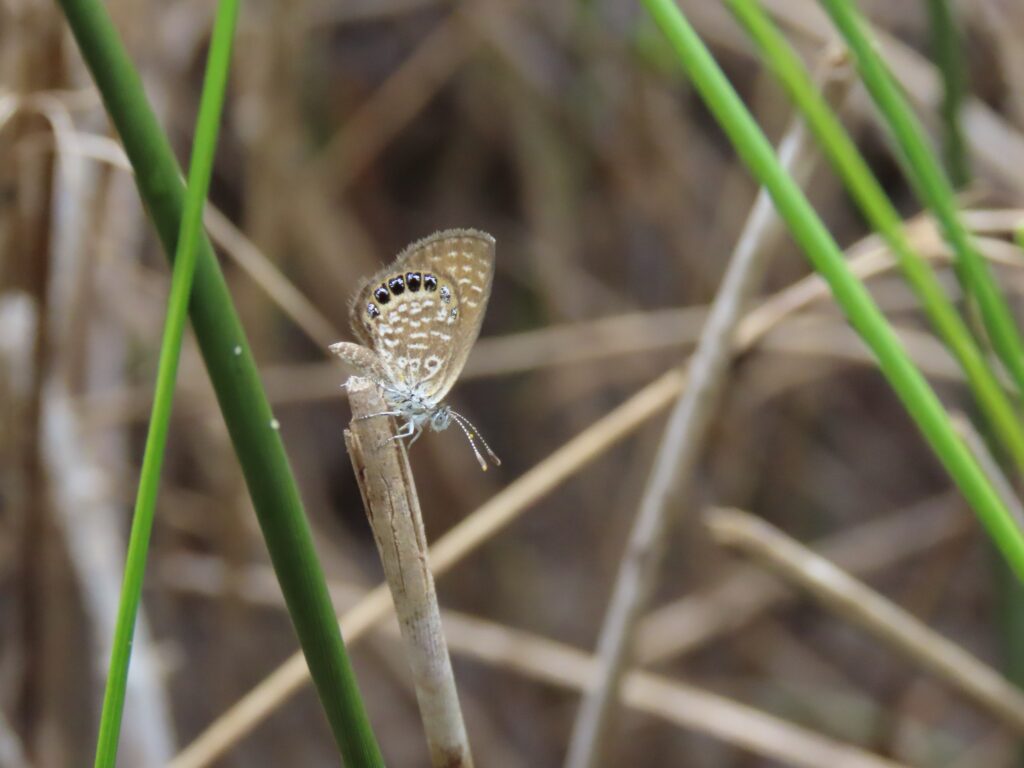
This week for Flora and Fauna Friday we have a pair of unrelated but extreme exemplifying butterflies, the Eastern Giant Swallowtail (Papilio cresphontes) and the Eastern Pygmy-Blue (Brephidium pseudofea).
The reason why I’ve decided to shine a spot light on these two unrelated species today is because they represent the full range of physical size for our native butterfly species here in South Carolina. Additionally, their preferred natural habitats overlap quite well and you may very well see both species on the same day in the same place. Let’s start with the little one.
The Eastern Pygmy-Blue is a miniscule butterfly in the Hairstreak family. Usually it’s no bigger than a fingernail. Its underside scales are overall a warm golden-brown down the wings, blending into a silvery-white body. Across the underwing are dashes of white and a trailing edge on the hindwing of six small black and metallic-silver eyespots. The upperside of females is a cinnamon-brown and males a darker shade of cinnamon but with a flash of sapphire blue over and along the body. The Pygmy-Blue can be a troublesome butterfly to find due to its itty-bittiness and preferred habitat, salt flats. The Eastern Pygmy-Blue caterpillar hosts on just as select few species of glassworts and so the adults can only be found in and around these sunny, soggy, sea-breezed, salt-saturated sand-lands. Adults begin flying in late spring and continue through to the end of summer in coastal South Carolina.
The Eastern Giant Swallowtail is a big honkin’ butterfly. They can grow nearly the size of your hand but are generally about six inches wide. Beyond their size, which dwarfs even our other swallowtails, they’re easy to identify by just their coloration. The upper surface of their wings is slate-black with a thick pastel-yellow line of blotches from one forewing tip straight through to the other and another line of yellow blotches running from the “wrists” of the forewings down where they make a “V” near the inner corner of the hindwings, just below a set of sky-blue and sunset-orange eyespots. From below they are even more distinctive, with the entire body and much of the wings being basted in a pure wash of butter-yellow. Through the center of the hindwing underside runs a series of powder-blue crescents and blood-orange blobs bordered with ink-black. The Eastern Giant Swallowtail is not a hard species to spot when you’re in the right place. They patrol the fringes of maritime forests and tidal creeks and are especially common along barrier islands and the Sea Islands. This is because they’re searching for or patrolling around their most prolific native host plant, Toothache Bush, which grows across the coast of the Lowcountry. The caterpillar of our Giant Swallowtail can also eat citrus leaves, and so they’re also a common visitor to orchards and coastal yards. Their caterpillar is easy to spot too. Not only is it big, it also has a distinctive color pattern of white, brown, and black blended together to create a perfect disguise as bird poop. This camouflage helps keep the caterpillars safe from avian predators but does make them stand out starkly against green foliage to the trained eye. Adult Giant Swallowtails fly from mid-spring until down into fall here in the Lowcountry.
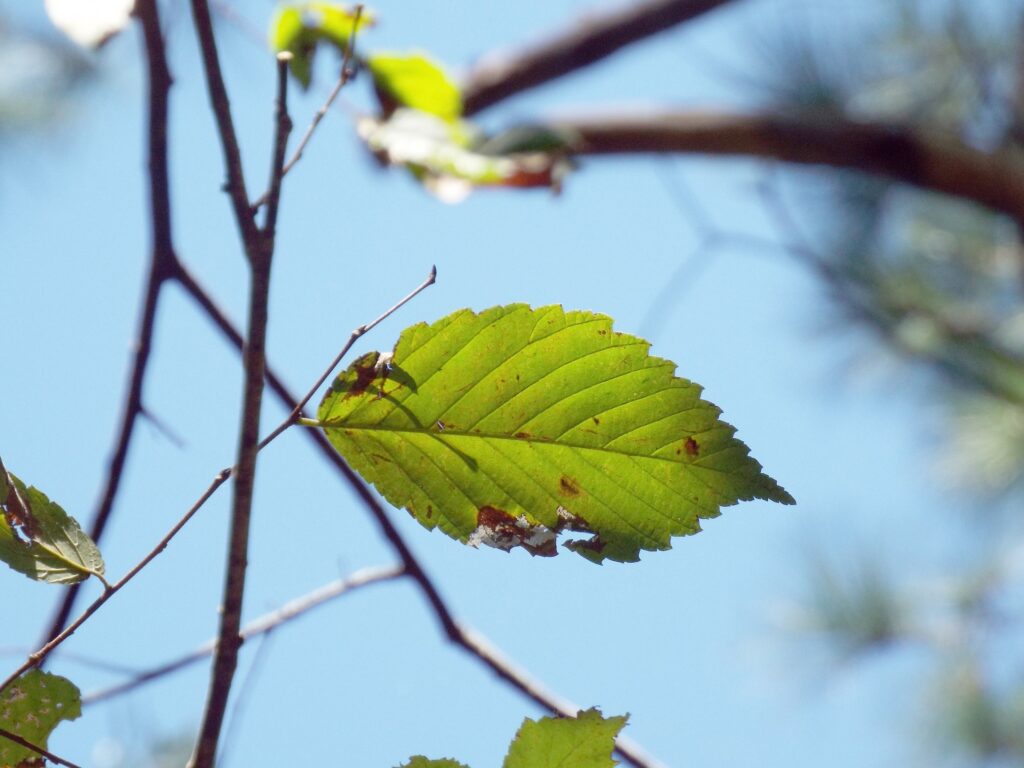
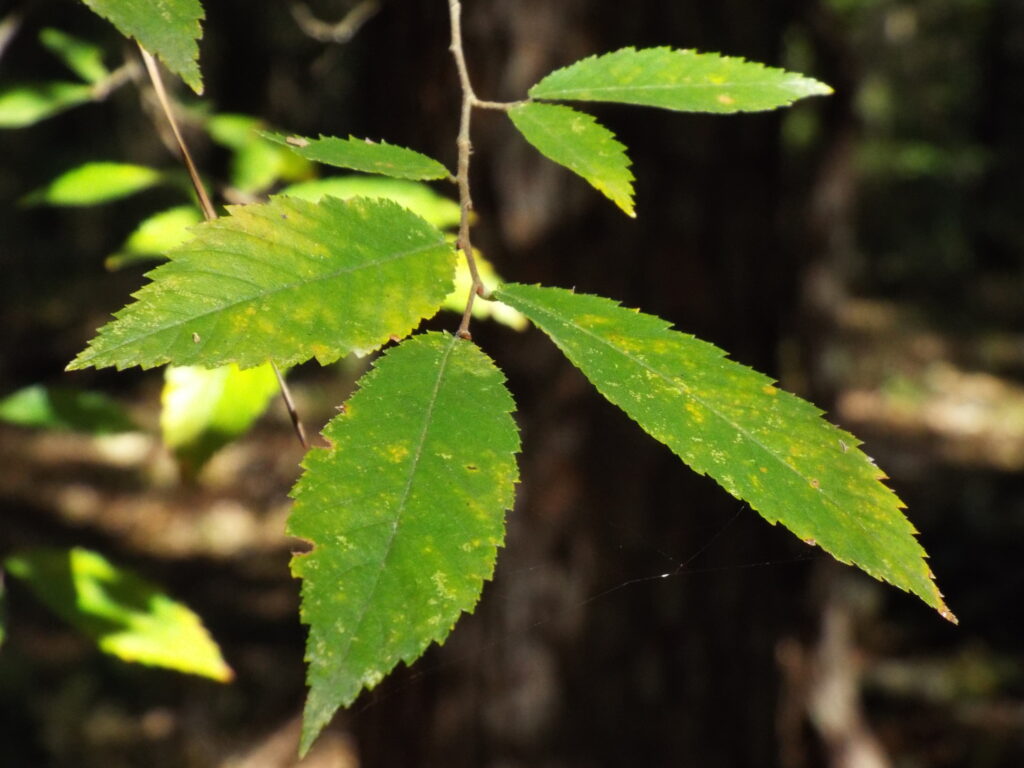

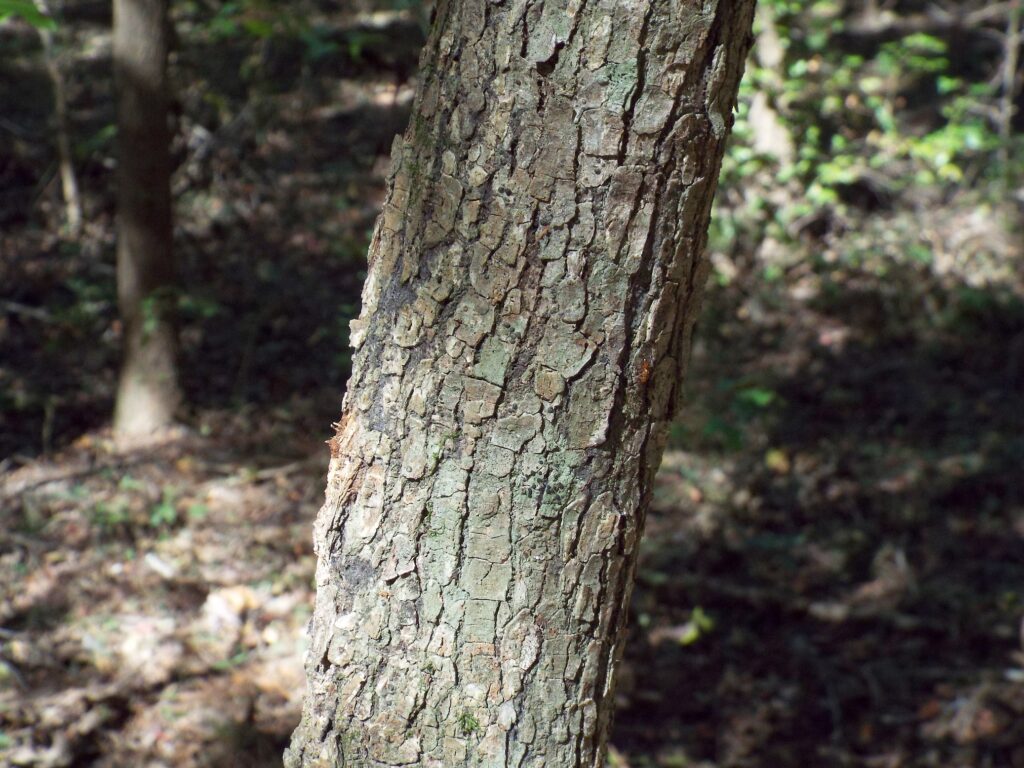
This week for Flora and Fauna Friday we’re simply going to be learning about our Elms, genus Ulmus.
Here on Edisto Island we have two native species of Elm, American Elm (U. americana) and Winged Elm (U. alata), and one exotic, Chinese Elm (U. parvifolia). All our Elms share a couple common characteristics. Elm trees tend to be about as wide as they are tall and, here in South Carolina, they maintain a compact height, usually not exceeding 50ft. All three of these elms also have a simple, elliptical leaf with prominently serrated margins and an alternate arrangement. The fruit of the tree is a dry winged seed called a samara. These samaras are compose of a single seed surrounded by a circular wing that catches the wind as the seed falls from the tree. To distinguish them by species, Chinese Elm is purely an ornamental exotic. It’s very common nowadays in urban parks, parking lots, and road islands but shows no characteristics of an invasive species in South Carolina. It has a very compact growth here in the Lowcountry, holds it small dark-green leaves throughout winter but sheds them in spring, and sports a beautiful calico bark of reds, grays, and yellows. Winged Elm is probably the easiest to spot. Its twigs, and the trunks of saplings, are flanked by broad, thin, corky wings of bark. Its leaves are small compared to American Elm. It is a fairly slow growing tree that demands full-sun and is most often found on field edges, clear-cuts, and stream banks. American Elm is the largest of the three by far, with a wide trunk covered in shaggy gray bark and a broad crown. Its leaves are roughly two to three inches in length and have the interesting characteristic of being asymmetrical at the base, with one side slightly longer. It prefers to grow along ditch edges, floodplains, and other rich, moist soils.
American Elm was once a massively popular landscape plant throughout the Eastern United States. However, the introduction of Dutch Elm Disease in the late 1920s caused a mass die-off of Elm trees across the country. Dutch Elm Disease is a fungal pathogen spread by beetles when they lay their eggs on Elm trees. The most prominent symptom is the death of upper limbs of the tree, eventually spiraling into the entire crown dying. Nowadays, very few Elm trees reach maturity before succumbing to the disease, leading to their relative rarity in modern forests. The American Elm was by far the hardest hit. The Winged Elm is also highly susceptible but its southeastern range is not as conducive to the spread of the disease. The ornamental Chinese Elm is highly resistant but still susceptible.
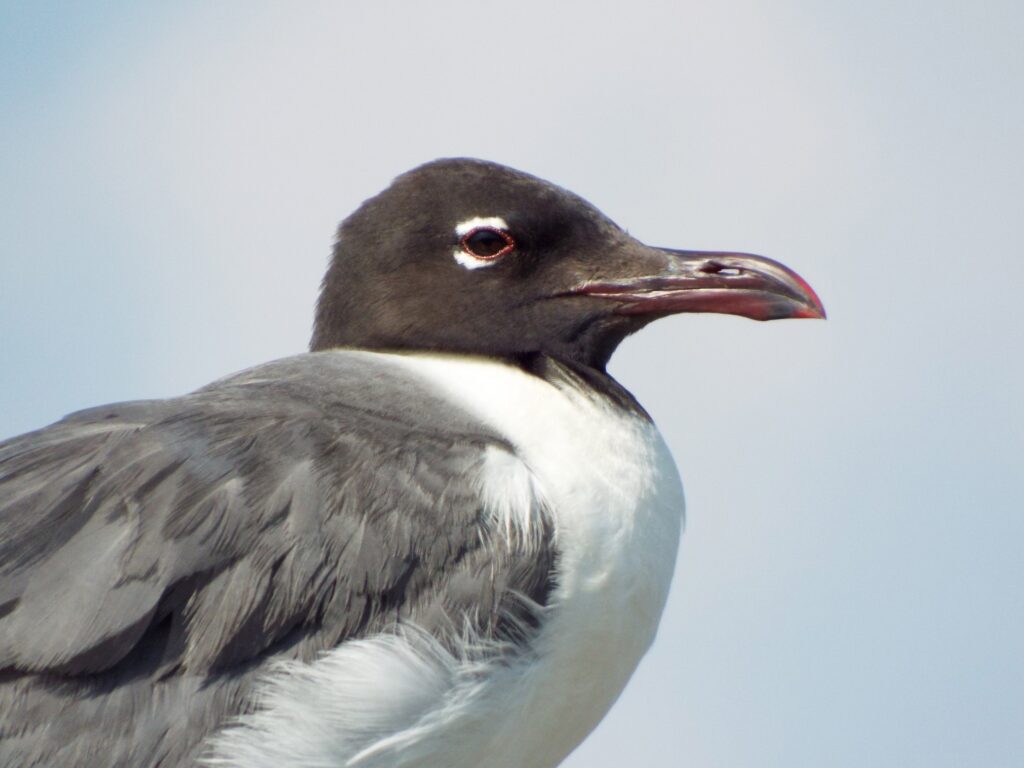
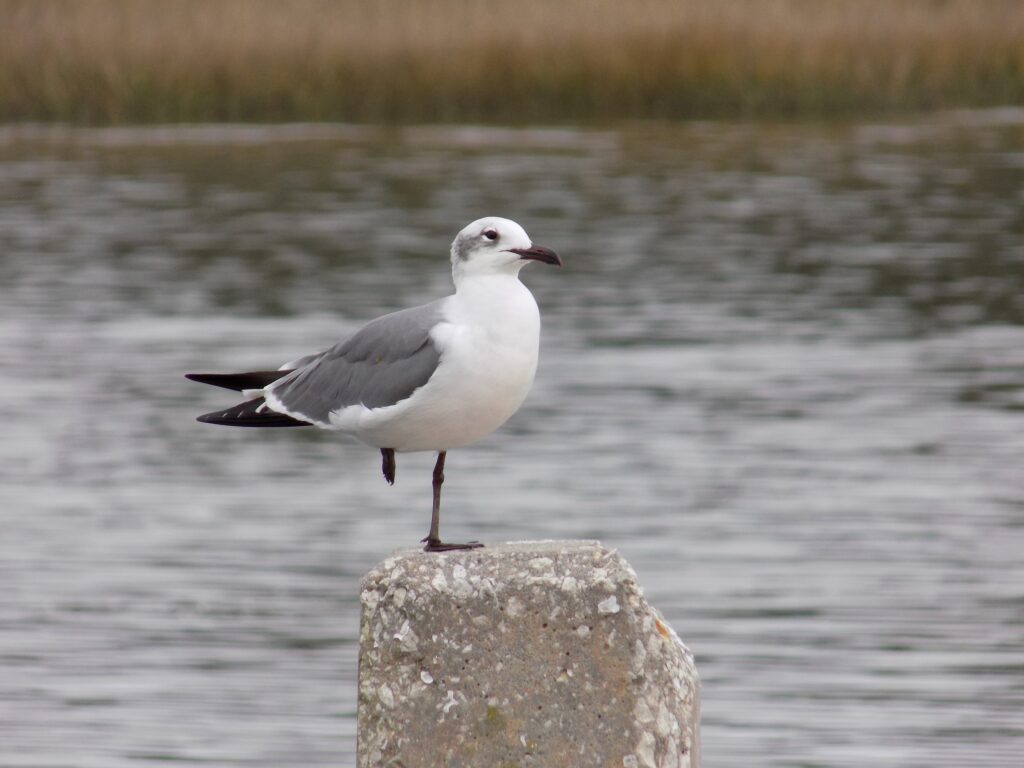
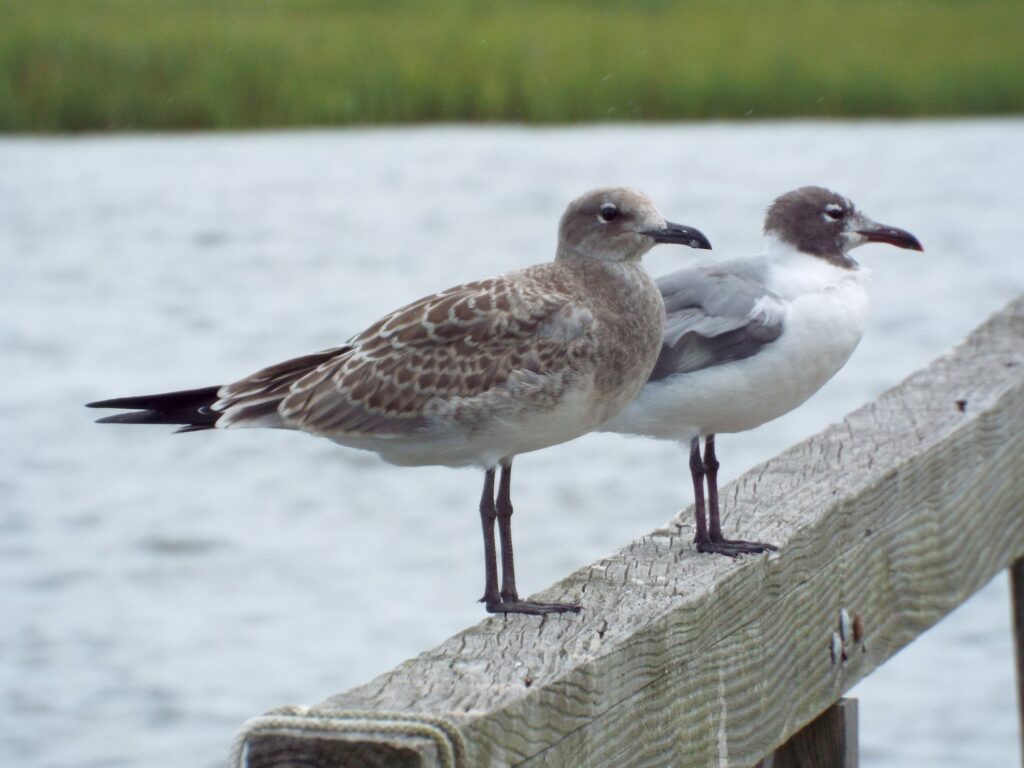
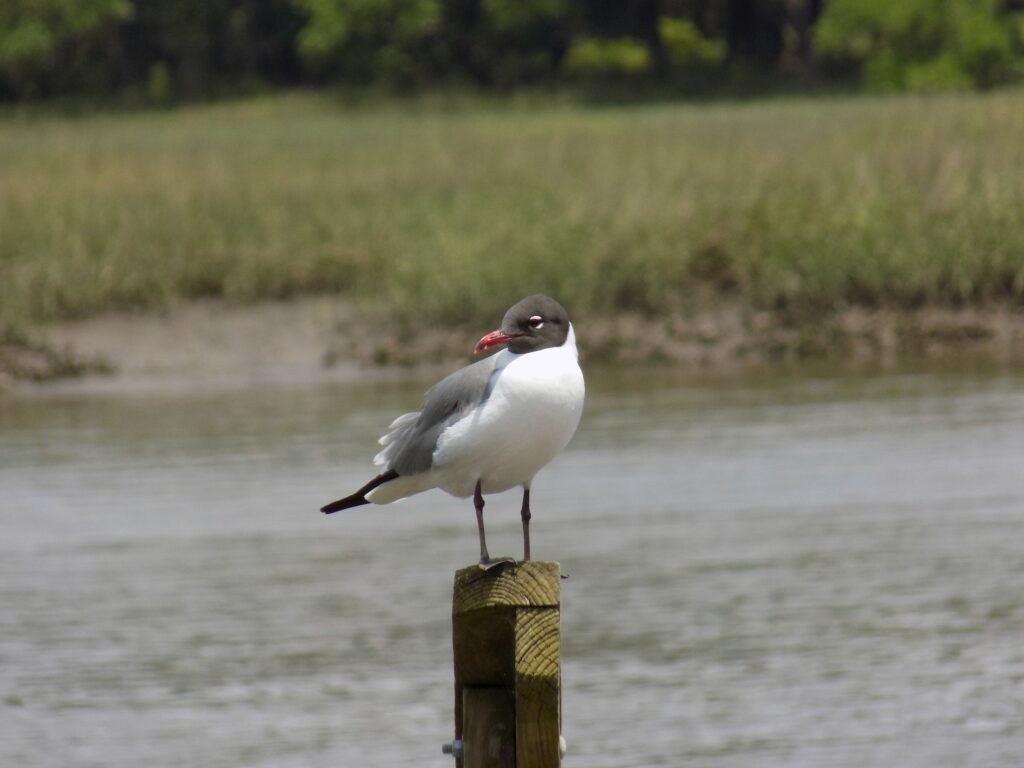
This week for Flora and Fauna Friday, we have the manically cackling seabird, the Laughing Gull (Leucophaeus atricilla).
Gulls are members of the family Laridae. This family includes Terns, Skimmers, Noddies, and Gulls. On Edisto, one species of Gull dominates the inland and coastal habitats. The Laughing Gull is our most common Gull and rules the island in the warmer months. In the winter, some head further south but there is always a presence in number year-round. Laughing Gulls are named for their distinct call, a derisive guffaw that sails through the sea breeze. They’re our second smallest Gull, which aids in identification by size. They’re otherwise easily identified by their dark-red legs and bill, slate gray back, and black-capped head in summer. In winter their plumage changes to faded shades of the same and a mostly white head but otherwise remains distinct.
Laughing Gulls are equally at home in the air, on the water, and on the ground. They typically stay close to tidal systems. Gulls are opportunistic omnivorous seabirds that will eat anything that suits their fancy. They are primarily carnivorous and will hunt fish, crabs, shrimp, shellfish, rodents, insects, and even shorebirds. They’re also scavengers and will eat any carrion that washes up on the beach. Most are also kleptoparasitic, meaning they steal from other animals. Gulls are well renowned for their ability to adapt to human environments and structures, such as marinas, grocery store parking lots, and garbage dumps. That’s thanks mostly to their bold nature and opportunistic diet. This makes them equally at home feeding above a school of fish on the open sea, stealing a Tern’s catch, swallowing wayward hotdogs whole at a ballpark, or picking at kitchen scraps at the municipal dump. This is an important new ecological niche that Gulls and Crows fill. Their adaptability helps fill ecological voids that might otherwise be exploited by more harmful invasive species, such as Black Rats and Feral Pigeons.
Whether we may want to or not, we share our island, our beach, and the handrails of our docks and boats with Laughing Gulls. No matter how tough things get, they’re a group of species that’s here to stay. There’s more to these birds beyond their proficiency at whitewashing decking lumber or swallowing half-eaten hamburgers. We should have an appreciation for their place in our coastal ecosystems and metropolitan landscapes.

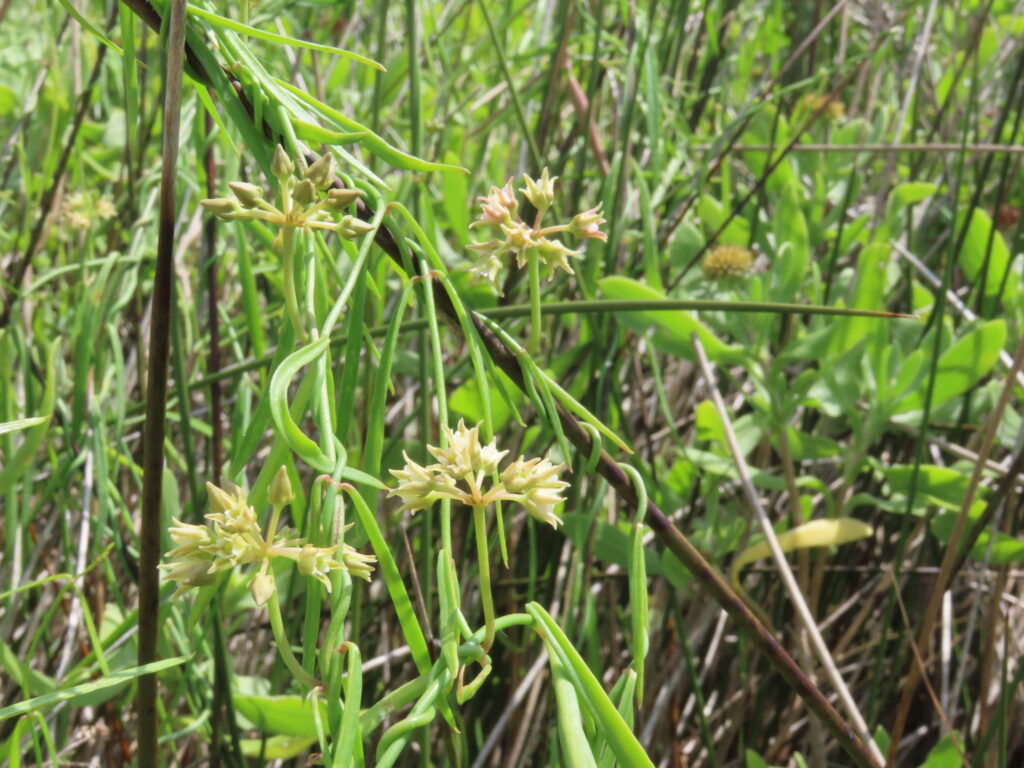
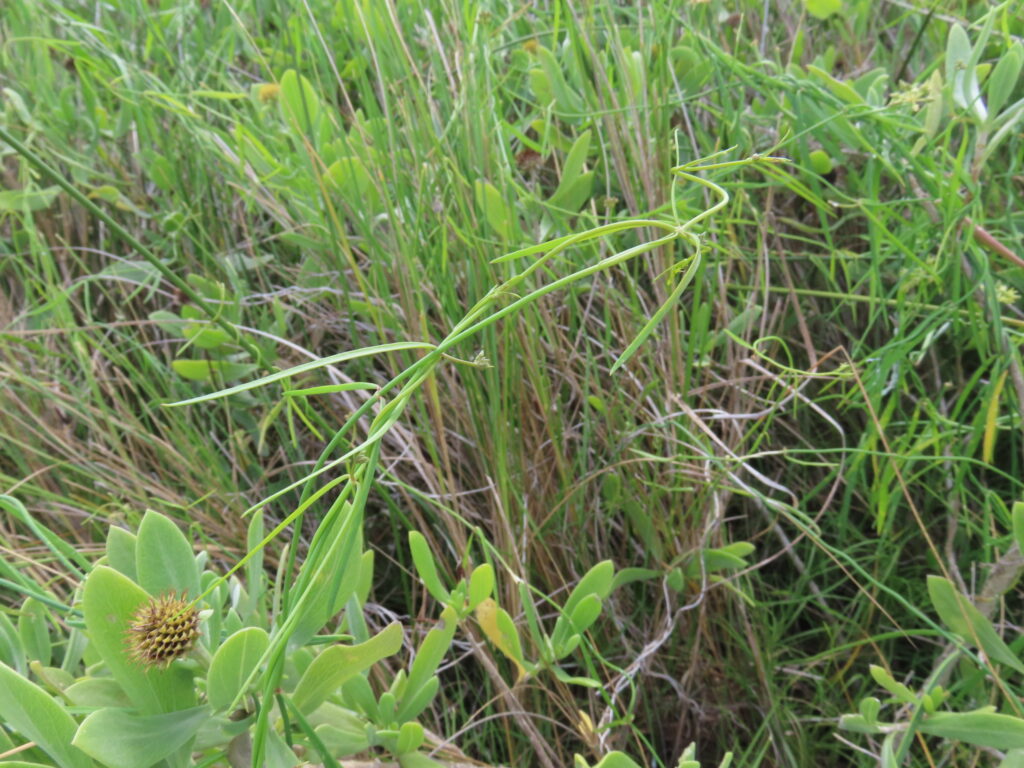
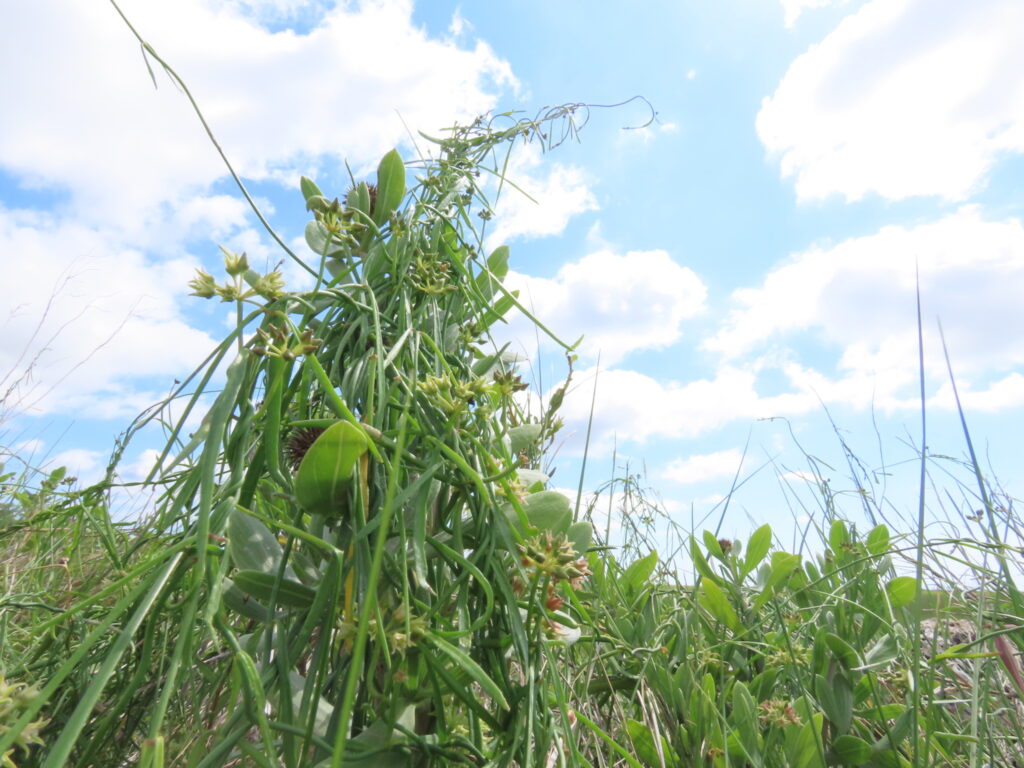
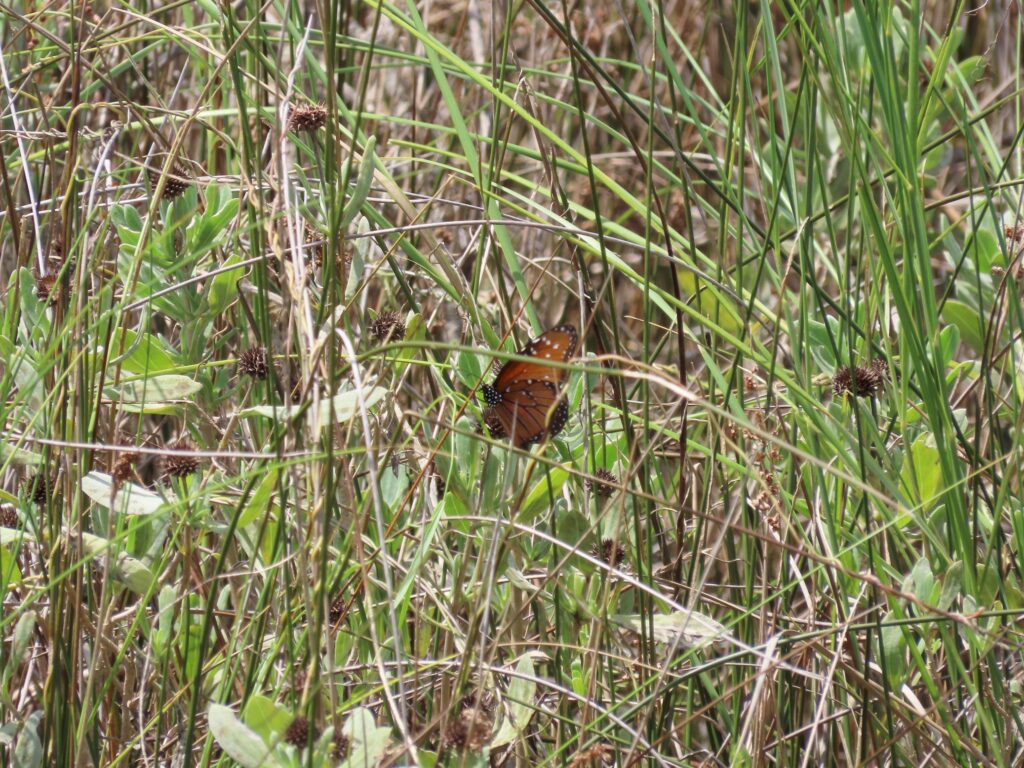
This week for Flora and Fauna Friday we have a salty twining vine with an underappreciated role in coastal Monarch conservation, Gulf Coast Swallowwort (Pattalias paluster).
Twining ‘round the Fimbry and tangled between the gnarled boughs of the Redcedar lies an unsuspecting vine. Gulf Coast Swallowwort is an herbaceous, perennial vine found along the extreme coast of the southeastern United States. It’s emerald-green foliage, thread-thin stem, and needle-like leaves allow it to blend in, almost undetectable, amidst the grasses, sedges, and rushes it grows overtop of. It’s found most commonly in maritime forests on barrier islands and the fringes of saltmarshes along our Sea Islands, including as Edisto Island. It prefers moist soils, full sun, and is fairly salt tolerant. As such, it can often be found along the banks of causeways, margins of feeder creeks, hammock islands, and just upland from sand flats. Swallowwort blooms throughout summer. Flowers are borne in spherical clusters with each flower being a five-point bell-like shape draped in a shade of pastel-green, accented inside with white and sometimes washed above with pastel-pink. The fruit of Swallowwort is a dry, spindle-shaped pod filled to the brim with cottony, wind-blown seeds.
What makes Gulf Coast Swallowwort important for coastal Monarch conservation is that it’s a member of the Milkweed family, Apocynaceae, and a host species that is able to support the Monarch’s larvae. It can also host the Queen, a tropical relative of the Monarch that makes its way to Edisto most years. Not only that, it’s one of very few native Milkweed species that can still be found growing wild and abundant along the extreme coast. Further inland, there are still many great protected lands which support a wide diversity of native Milkweeds. However, here on the Sea Islands, many of those species can’t survive in salt intruded soils and those that once grew on the uplands have long since been pushed to near eradication by prolonged past agricultural use. This leaves Swallowwort as the sole native Milkweed on all of our barrier Islands and much of the Sea Islands. Although the Lowcountry’s resident population of non-migratory Monarchs is not yet well understood, I can’t imagine Swallowwort doesn’t help bind our Sea Islands back to the mainland and create a bridge for this imperiled butterfly species to recolonize the coast.
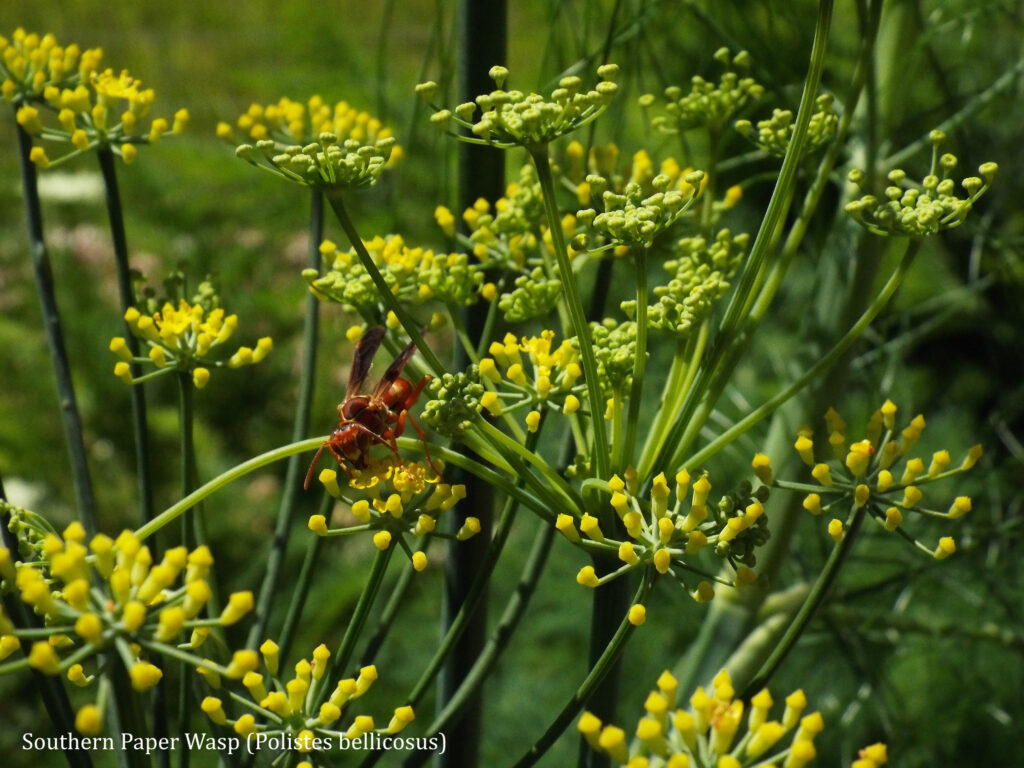
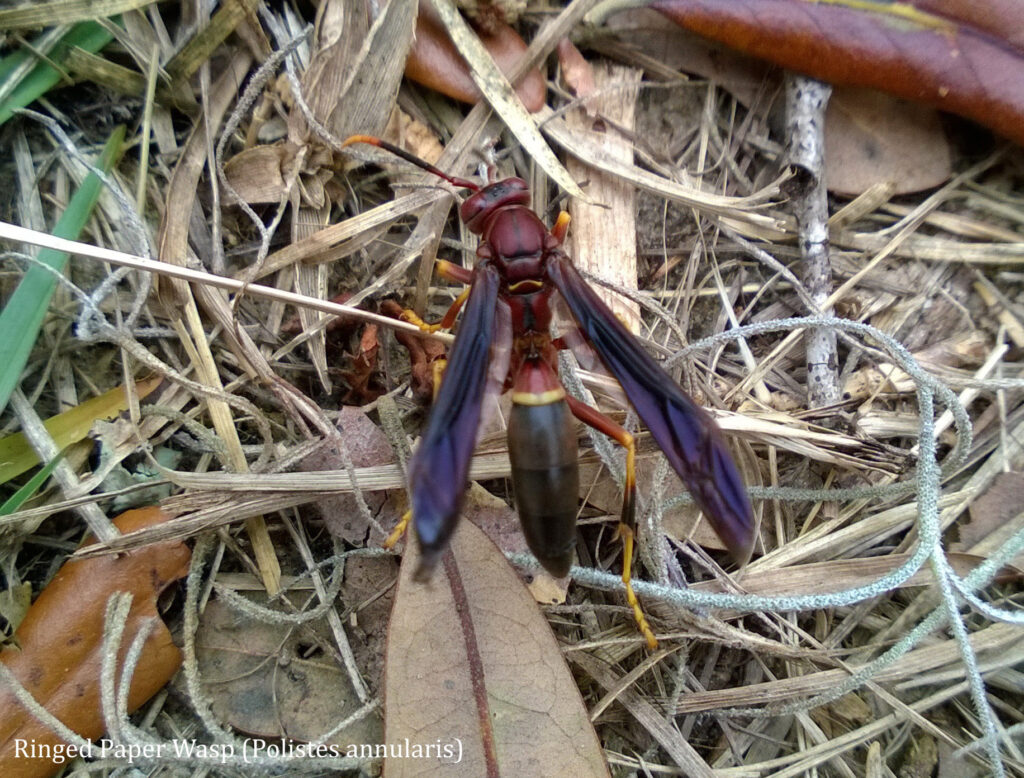
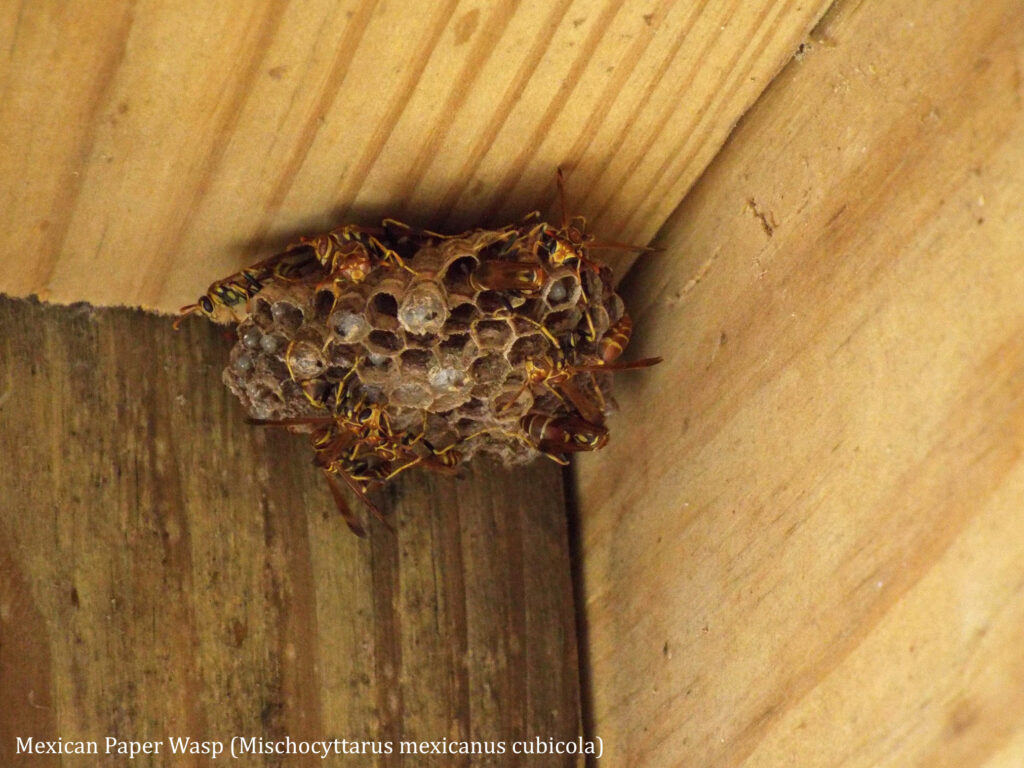
This week for Flora and Fauna Friday we have a collection of communally living insects who don’t always make the best neighbors, the Umbrella Paper Wasps of subfamily Polistinae.
Paper Wasps are a clade of wasps that build nests out of “paper”. They chew on dry, dead wood and stems to collect wood pulp, chew it up into a paste, and then meticulously construct an intricate nest one mouthful at a time. Today I’m focusing on the Umbrella Paper Wasps who build upside-down, open-face nests on the limbs of shrubs, in the cavities of trees, or the underside of under-used lawn furniture. Paper Wasps are all eusocial insects, meaning there is a “queen” who founds a colony and gives birth to subservient, infertile workers who then go about managing, maintaining, and expanding the nest. Umbrella Paper Wasp colonies are fairly small compared to other eusocial insects, like ants and honeybees, and usually clock in between 1 to 4 dozen individuals. Colonies only last a year, with the queen’s fertile offspring overwintering to found new colonies the next spring.
Paper Wasp nests are a common sight under eaves and porches, and other inconvenient places throughout South Carolina. We have several species of this subfamily common throughout the state but two which are particularly common here around Edisto that I’d like to shine a light on: the Ringed Paper Wasp (Polistes annularis) and the Mexican Paper Wasp (Mischocyttarus mexicanus cubicola). These two species are the two you’re most likely to encounter taking up shop in the crook of your awning or underside of your rocking chair. The Ringed Paper Wasp, or Jack Spaniard Wasp, is found throughout the Southeast. It’s about an inch and a half long with black wings, a black abdomen, brick-red body, yellow feet, and a yellow ring around the waist. They’re big for a Paper Wasp and, in my experience, they’re far more aggressive than other species. Most Umbrella Paper Wasps are fairly docile and it takes a concerted effort, or really poor luck, to get them to rouse. However to me it seems like Ringed Paper Wasps are always itching for a fight. All female Umbrella Paper Wasps can sting and I can tell you from experience that the sting of the Ringed Paper Wasp is particularly painfully. Said species’ sting usually resulting in a white-hot searing pain, throbbing soreness, and light inflammation at the site of envenomation. Conversely, the Mexican Paper Wasp is very docile and they tend to just stare passive-aggressively at you from their nest unless you get dangerously close. This species is common on the extreme coast of South Carolina, down into the coastal plain of the lower Southern states. The Mexican Paper Wasp is petite at about an inch in length. Their coloration is a brick-red base on much of the body with prolific rings and markings of lemon-yellow, and black undertones on the upper legs and thorax. Their small abdomen and elongated waist sets them apart from smaller members of the Polistes genus.
Paper Wasps have an interesting diet and, as a result, an irreplaceable role in our ecosystems that many overlook. Paper Wasps are actually a very important pollinator. A significant portion of their diet comes from nectar, which they sip directly from wildflowers, pollinating them in the process. They also incidentally pollinate flowers while collecting their primary food source, caterpillars. Paper Wasps patrol flower, leaf, and stem of all manner of wildflower, grass, tree, and shrub on the hunt for caterpillars. Captured caterpillars are either eaten by the wasp that found it or brought back to the nest to feed their sisters and carnivorous larvae. The ability of Paper Wasps to hunt the caterpillars of innumerable moth and caterpillars is second to none. This provides an invaluable ecosystem service in the form of pest control for farmers and gardeners and, in the strictly natural setting, is a critical link in the natural checks and balances for population control of certain plants and moths. Without the Paper Wasps, certain moths and butterflies would multiply unchecked, defoliating and/or killing many plant species across an entire ecosystem, decreasing plant diversity at best or totaling destabilizing certain fragile ecosystems at worst. Of course, Paper Wasps don’t do all the work. Caterpillars make up a majority of quite a number of species’ diets but the seasonal consistency and non-specific targeting of Paper Wasps puts them in another league.
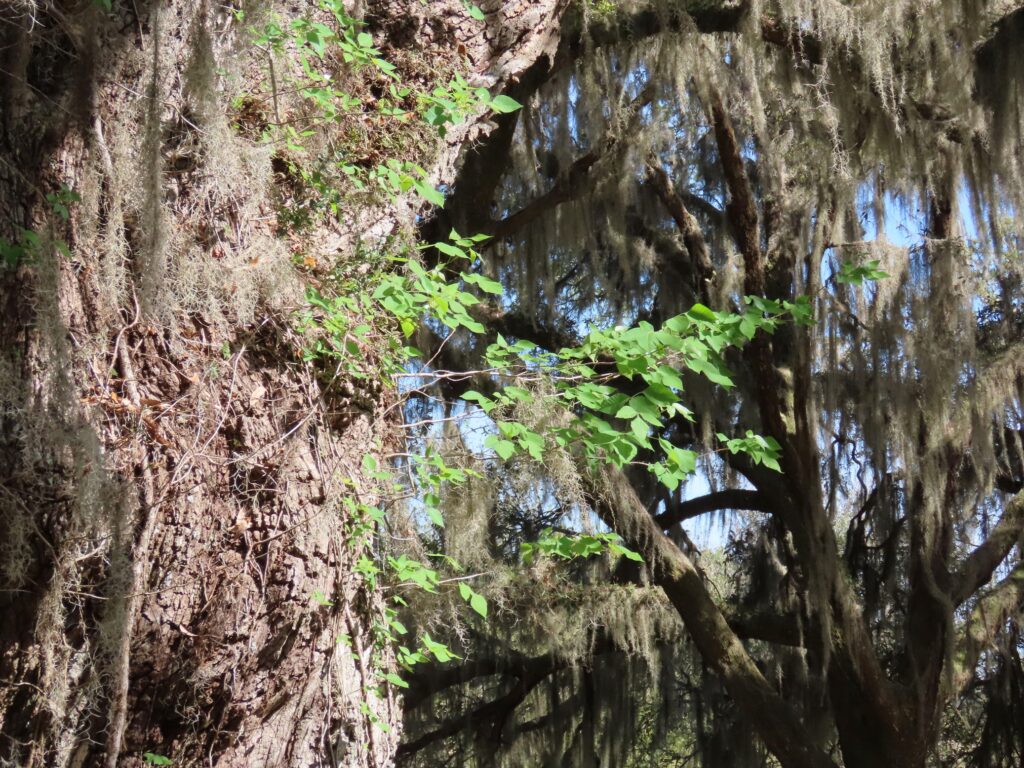

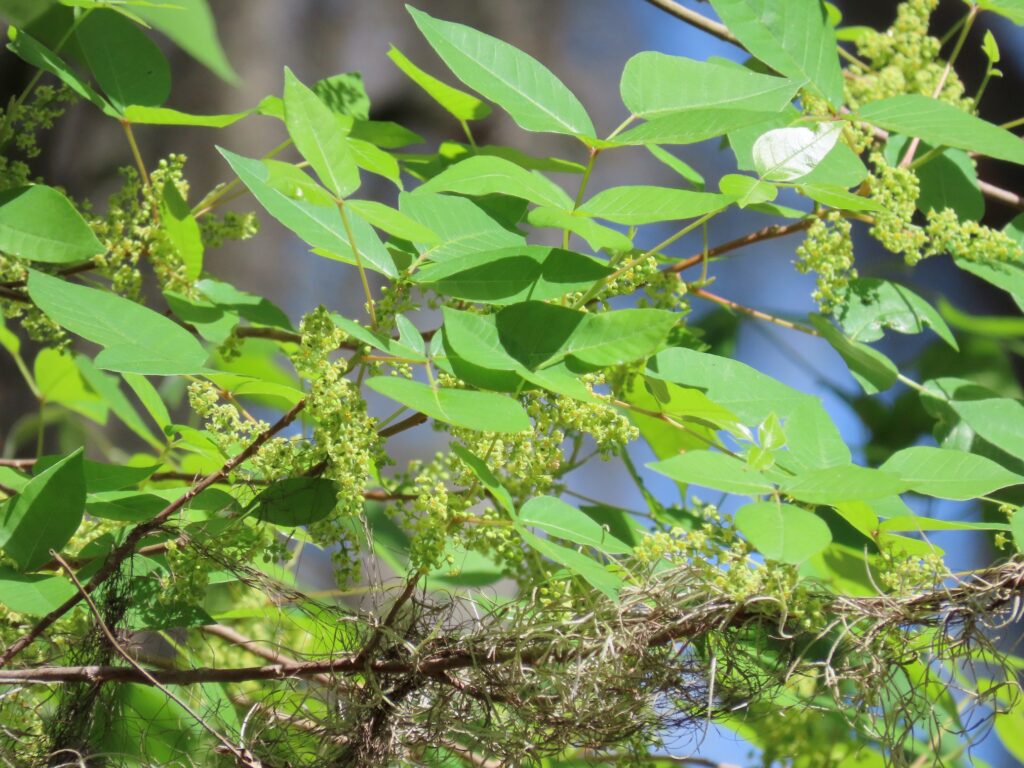
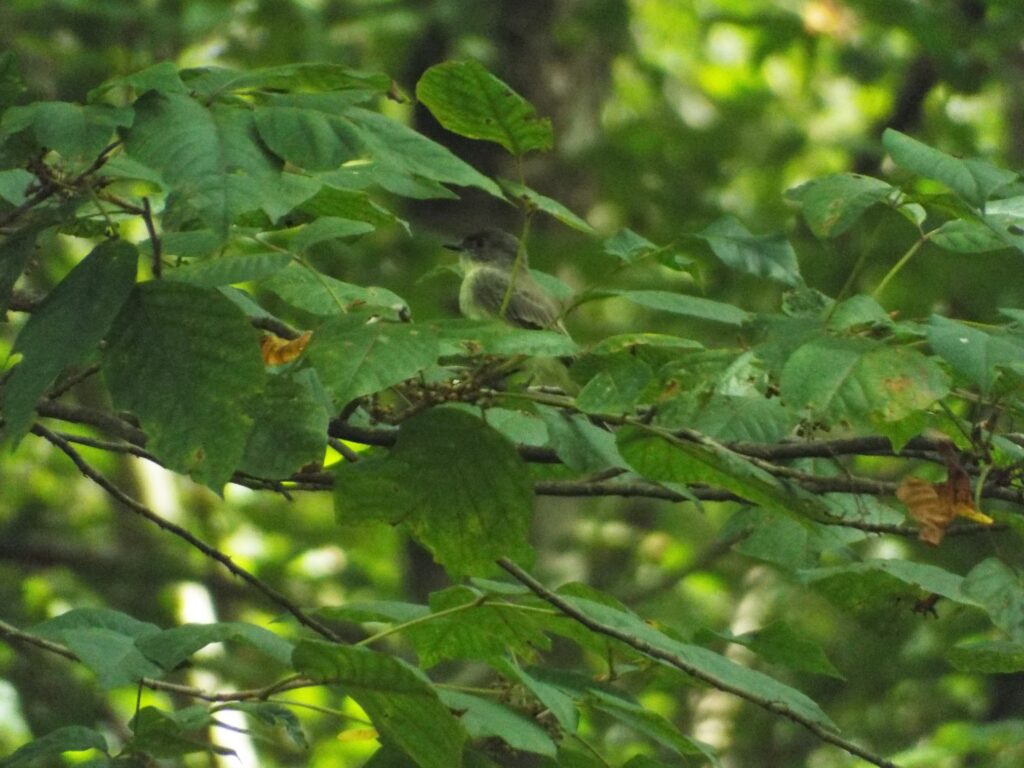
This week for Flora and Fauna Friday we have the most reviled vine in the Southeast, Poison-Ivy (Toxicodendron radicans).
Much maligned, this unsuspecting vine seems to be the scourge of all those would be wanderers of the woods. Few plants garner as visceral of a reaction from folks as today’s Poison-Ivy. However, I’m here today not just to tell cautionary tales but also to share the many merits of this persistently persecuted plant.
Poison-Ivy is found throughout the Eastern United States. It’s not a true Ivy but instead a relative of Cashews, Mangos, and Sumacs. Poison-Ivy, along with its cousins Poison-Oak (T. pubescens) and Poison-Sumac (T. vernix), can all be found in South Carolina. Poison-Oak grows as a small shrub and is partial to sandhills and Longleaf Pine Savannas. Poison-Sumac can grow into a small tree and is found on saturated soils along wetlands. Poison-Ivy grows primarily as a vine but can become a shrub on especially sandy soils or a groundcover in open areas. When growing as a vine, Poison-Ivy prefers to cling to the side of a tree using a profusion of tiny rootlets. These rootlets wriggle into the bark of the host tree, firmly anchoring the vine in place all the way up throughout the canopy. Poison-Ivy vines can eventually reach the size of your thigh, given enough time. These hairy vines are one of the key ways to identify Poison-Ivy at a glance. The other is by its leaves. Poison-Ivy leaves are compound with three leaflets, giving a vague resemblance to English Ivy, where it derives the “Ivy” part of its name. This three leaflet arrangement is consistent but the shape of the leaflets is not. The leaflets themselves can be highly glossy or nearly matte on the surface and their margins can be either straight, toothed, or semi-lobed.
Poison-Ivy provides many benefits to wildlife. In late April into May it blooms with clusters of greenish-white flowers enjoyed by a wide array of pollinating species. Further on into late summer, the fruits of their pollinated flowers mature into tiny off-white drupes, which are scoffed down by many of our songbirds. These birds then scatter the seeds of Poison-Ivy far and wide. Come fall, the deciduous leaves of Poison-Ivy are shed with an autumnal display of crimson and blood-orange. However, before that foliage is shed, it can be eaten by a wide variety of foraging mammals including Deer, Woodrats, and Raccoons, all of whom are unaffected by the Poison of this Ivy. Which leads us to the reason why most of us despise this plant.
Every part of the Poison-Ivy plant contains a compound called Urushiol. It is especially concentrated in the sap of the plant. (This compound is also produced by Poison-Oak and Poison-Sumac as well as certain parts of Cashew and Mango trees.) When a person leans against the trunk of a Poison-Ivy vine, steps on its leaves, digs up a root, or stands inside smoke from a brush fire containing the vines, then they may experience what’s called Urushiol-induced contact dermatitis. For those uninitiated, it’s one wicked rash and not something to take lightly. Symptoms generally manifest a day or two after exposure and can take several weeks to clear out. This is actually an allergic reaction happening under the skin after the Urushiol dissolves down into the dermis. The only way to prevent the reaction is to wash all exposed skin with a special soap before the Urushiol can absorb into the skin. Every individual has a different tolerance to Urushiol and severity of reaction. Some people are almost entirely immune and others can have horrible reactions from the most minimal of contact. Generally, your sensitivity increases with age and after each exposure.

This week for Flora and Fauna Friday we have a lemon-lipped homewrecker of a bird, the Yellow-billed Cuckoo (Coccyzus americanus).
The Yellow-billed Cuckoo, colloquially known as the Rain-Crow, is a large and peculiar bird. It, along with its much less Lowcountry common cousin the Black-billed Cuckoo (C. erythropthalmus), are the only two members of their order found widely within the eastern United States. The Yellow-billed Cuckoo has a marble-white belly, brown-gray back, rusty-brown wing tips, and a long tail that’s brown above and black below but broken up beneath with three pairs of white blobs. The brown of their back flows up over the head to meet the white of the belly just below their black eye, which is sometimes ringed in yellow. Their namesake beak is heavy and two-toned, black above and lemon-yellow below. The song of the Rain-Crow is quite distinctive, albeit a bit bland. They can be heard from nearly a mile off, letting loose a monotonous series of dry but resonant “kuh”s, like something between a cough and a wheeze. Their call is just as recognizable, a persistent rising string of sharp knocks, sometimes ending with a slew of brief, percussive rolls.
Yellow-billed Cuckoos are summer residents, flying in in late spring to breed and then departing in fall. Cuckoos build nests and lay eggs like any other bird. However, they’re also brood parasites, meaning they’ll lay eggs in the nests of other birds but, unlike the Brown-headed Cowbird, they’re not obligated to do so. Generally, they parasitize the nests of large songbird species but will also parasitize other Cuckoos. Yet, Yellow-billed Cuckoos rarely do so unless food is particularly abundant in their territory. In order to capitalize on the brood parasitism strategy, Cuckoo eggs are also extremely fast maturing. This allows their young to get a head start when laid in another species’ nest. To counteract this rapid maturation when raising their own young, they lay their eggs asynchronously, allowing eggs to hatch several days apart and lessening the burden on the adults who would otherwise need to feed all those hungry mouths at once. Yellow-billed Cuckoos are primarily insectivorous and spend their days patrolling hardwood forests looking for food. They are the number one predator of Fall Webworms and Tent Caterpillars, using their strong bill to tear into those silken fortresses and gorge themselves on the caterpillars inside. They also hunt cicadas, katydids, and other such noisy nuggets of summer. Cuckoos will also feed on various fruits when available.